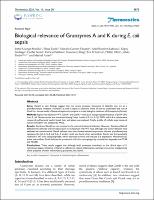Please use this identifier to cite or link to this item:
https://repositorio.usj.es/handle/123456789/784
| Title: | Biological relevance of Granzymes A and K during E. coli sepsis |
| Authors: | Uranga-Murillo, Iratxe


Tapia-Casellas, Elena 
Garzón-Tituana, Marcela 

Ramírez-Labrada, Ariel 

Santiago, Llipsy 
Pesini, Cecilia 
Esteban, Patricia 

Roig, Francisco J. 

Galvez, Eva M. 
Bird, Phillip Ian 

Pardo, Julián 

Arias, Maykel 
|
| Keywords: | Granzyme K; Granzyme A; Bacterial sepsis; Inflammation |
| Issue Date: | 17-Oct-2021 |
| Publisher: | IVYSPRING INT PUBLPO BOX 4546, LAKE HAVEN, NSW 2263, AUSTRALIA |
| Citation: | Uranga-Murillo I, Tapia E, Garzón-Tituaña M, Ramirez-Labrada A, Santiago L, Pesini C, Esteban P, Roig FJ, Galvez EM, Bird PI, Pardo J, Arias M. Biological relevance of Granzymes A and K during E. coli sepsis. Theranostics 2021; 11(20):9873-9883. doi:10.7150/thno.59418. Available from https://www.thno.org/v11p9873.htm |
| Abstract: | Aims: Recent in vitro findings suggest that the serine protease Granzyme K (GzmK) may act as a proinflammatory mediator. However, its role in sepsis is unknown. Here we aim to understand the role of GzmK in a mouse model of bacterial sepsis and compare it to the biological relevance of Granzyme A (GzmA). Methods: Sepsis was induced in WT, GzmA-/- and GzmK-/- mice by an intraperitoneal injection of 2x108 CFU from E. coli. Mouse survival was monitored during 5 days. Levels of IL-1α, IL-1β, TNFα and IL-6 in plasma were measured and bacterial load in blood, liver and spleen was analyzed. Finally, profile of cellular expression of GzmA and GzmK was analyzed by FACS. Results: GzmA and GzmK are not involved in the control of bacterial infection. However, GzmA and GzmK deficient mice showed a lower sepsis score in comparison with WT mice, although only GzmA deficient mice exhibited increased survival. GzmA deficient mice also showed reduced expression of some proinflammatory cytokines like IL1-α, IL-β and IL-6. A similar result was found when extracellular GzmA was therapeutically inhibited in WT mice using serpinb6b, which improved survival and reduced IL-6 expression. Mechanistically, active extracellular GzmA induces the production of IL-6 in macrophages by a mechanism dependent on TLR4 and MyD88. Conclusions: These results suggest that although both proteases contribute to the clinical signs of E. coli-induced sepsis, inhibition of GzmA is sufficient to reduce inflammation and improve survival irrespectively of the presence of other inflammatory granzymes, like GzmK. |
| URI: | https://repositorio.usj.es/handle/123456789/784 |
| ISSN: | 1838-7640 |
| Appears in Collections: | Artículos de revistas |
Files in This Item:
| File | Description | Size | Format | |
|---|---|---|---|---|
| Biological relevance of Granzymes A and K during E. coli.pdf | 1,28 MB | Adobe PDF |  View/Open |
This item is licensed under a Creative Commons License

